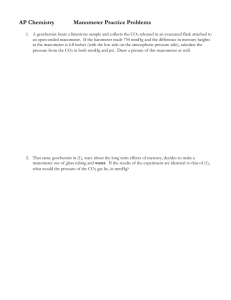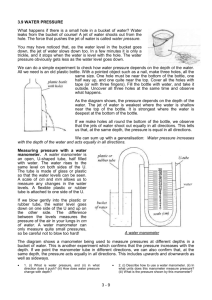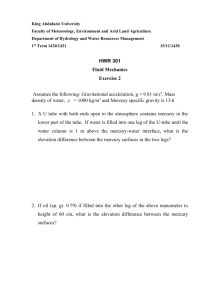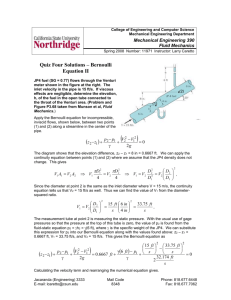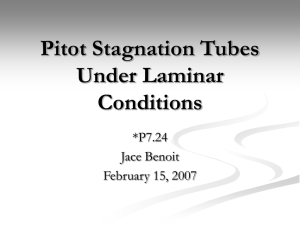fluids exp 3
advertisement
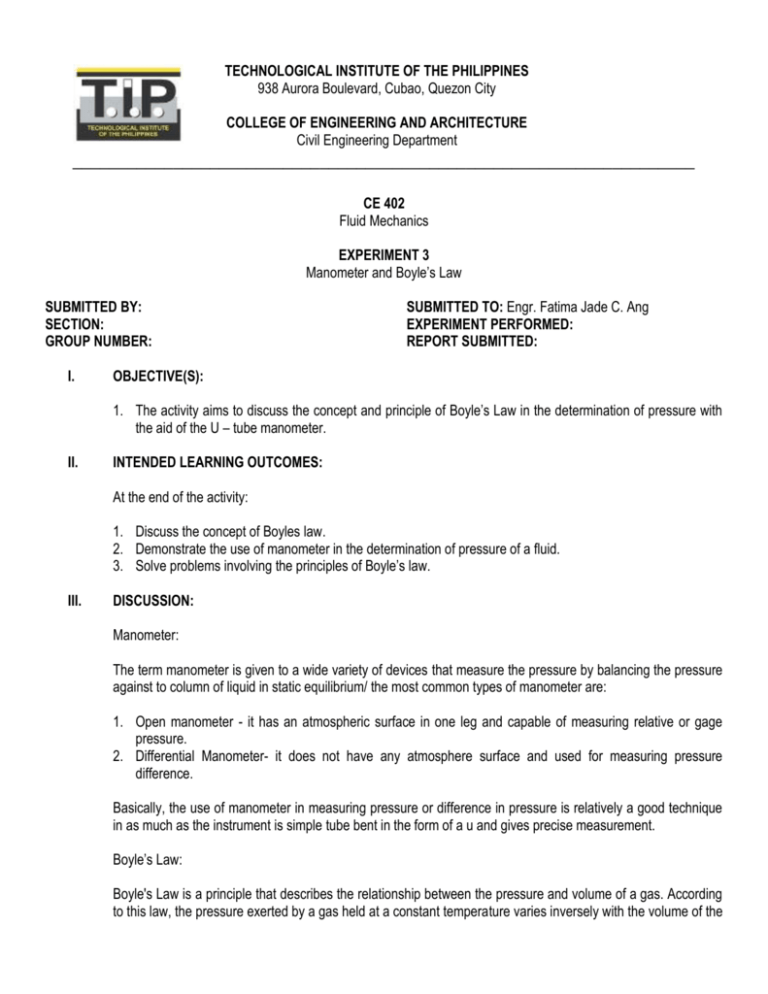
TECHNOLOGICAL INSTITUTE OF THE PHILIPPINES 938 Aurora Boulevard, Cubao, Quezon City COLLEGE OF ENGINEERING AND ARCHITECTURE Civil Engineering Department ____________________________________________________________________ CE 402 Fluid Mechanics EXPERIMENT 3 Manometer and Boyle’s Law SUBMITTED BY: SECTION: GROUP NUMBER: I. SUBMITTED TO: Engr. Fatima Jade C. Ang EXPERIMENT PERFORMED: REPORT SUBMITTED: OBJECTIVE(S): 1. The activity aims to discuss the concept and principle of Boyle’s Law in the determination of pressure with the aid of the U – tube manometer. II. INTENDED LEARNING OUTCOMES: At the end of the activity: 1. Discuss the concept of Boyles law. 2. Demonstrate the use of manometer in the determination of pressure of a fluid. 3. Solve problems involving the principles of Boyle’s law. III. DISCUSSION: Manometer: The term manometer is given to a wide variety of devices that measure the pressure by balancing the pressure against to column of liquid in static equilibrium/ the most common types of manometer are: 1. Open manometer - it has an atmospheric surface in one leg and capable of measuring relative or gage pressure. 2. Differential Manometer- it does not have any atmosphere surface and used for measuring pressure difference. Basically, the use of manometer in measuring pressure or difference in pressure is relatively a good technique in as much as the instrument is simple tube bent in the form of a u and gives precise measurement. Boyle’s Law: Boyle's Law is a principle that describes the relationship between the pressure and volume of a gas. According to this law, the pressure exerted by a gas held at a constant temperature varies inversely with the volume of the gas. For example, if the volume is halved, the pressure is doubled; and if the volume is doubled, the pressure is halved. Boyle's Law actually applies only to an ideal, theoretical gas. When real gases are compressed at a constant temperature, changes in the relationship between pressure and volume occur. However, the law is accurate enough to be useful in a number of practical applications. It is used, for example, in calculating the volume and pressure of internal-combustion engines and steam engines. The law was first stated in 1662 by Robert Boyle. In 1676, Edme Mariotte of France independently stated the same law, and it is sometimes called Mariotte's Law. Stated as a formula, Boyle's Law reads: P1V1 = P2V2 (at constant temperature) Where: V1 = original volume V2 = final volume P1 = original pressure P2 = final pressure IV. RESOURCES: U – Tube manometer Rubber tubing Funnel Prophylactic or thin sheet of rubber Water Colored Liquid V. PROCEDURE: 1. Set up a manometer with a liquid inside the tube. 2. Connect the rubber tubing at one end of the manometer while the other end at the smaller end of the funnel. 3. Slowly immerse the glass funnel down to the water (in the container) allowing the water to enter. 4. Take note of the difference in height of the surface of a liquid in the manometer. Designate it as h. 5. Also take note the height of water that enters into the glass funnel, designate that as h 1. Record as well the diameter of the water surface that enters the funnel. Designate it as d. 6. Repeat set up 1 to 5 with other liquids. 7. Evaluate pressure using the formula below: p1 v1 = p2 v2 π V = ( 3 ) (R2 + r + Rr) P1= 101.23 kPa π 2 V2 = ( ) (R +r21 +rr1 ) (h-h1 ) 3 P2 = po +yh2o Sg Hg hg Newton’s Law of approximation 3rd degree: h=h-p(h1 )/p(h1 ) h-h1 x= (R-r) h r1 = r+x (h-h2 )/h(R-r) x r-r = h-h1 h VI. DATA AND RESULTS: Fluid Computation: d (cm) h (cm) h1 P2 (kPa) Documentation: VII. OBSERVATION(S): VIII. CONCLUSION(S): IX. RECOMMENDATION(S): X. ASSESSMENT: CRITERIA BEGINNER 1 ACCEPTABLE 2 PROFICIENT 3 Members do not demonstrate needed skills. Members are unable to set-up the materials. Members do not demonstrate targeted process skills. Members do not follow safety precautions. Members occasionally demonstrate needed skills Members are able to set-up the materials with supervision. Members occasionally demonstrate targeted process skills. Members follow safety precautions most of the time. I. Laboratory Skills Manipulative Skills Experimental Set-up Process Skills Safety Precautions II. Work Habits Time Management / Conduct of Experiment Members do not finish Members finish on on time with time with incomplete incomplete data. data. Members do not know their tasks and have no defined Cooperation and responsibilities. Teamwork Group conflicts have to be settled by the teacher. Neatness and Orderliness Messy workplace during and after the experiment. Ability to do independent work Members require supervision by the teacher. Other Comments/Observations: Members always demonstrate needed skills. Members are able to set-up the material with minimum supervision. Members always demonstrate targeted process skills. Members follow safety precautions at all times. Members finish ahead of time with complete data and time to revise data. Members have defined Members are on tasks and responsibilities most have defined of the time. Group responsibilities at all times. conflicts are Group conflicts are cooperatively cooperatively managed at managed most of the all times. time. Clean and orderly Clean and orderly workplace with workplace at all times occasional mess during and after the during and after the experiment. experiment. Members require occasional Members do not need to be supervision by the supervised by the teacher. teacher. Total Score Rating= (Total Score) ×100 24 SCORE XI. QUESTIONS AND PROBLEMS: 1. A glass 1.60 m long and having a diameter of 2.50 is inserted vertically into tank oil (y= 0.80) with the open end down and the closed end uppermost. If the open end is submerged 1.30 m from the oil surface, determine the height to which the oil will raise bin the tube. Assume barometric pressure is 100 kPa and neglect vapor pressure. 2. The manometer in the figure is taped to a pipeline carrying oil (y= 0.85). Determine the pressure at the centerline of the pipe. (h= 0.30m) 3. Give the common types of manometer and discuss their usage and differences.
